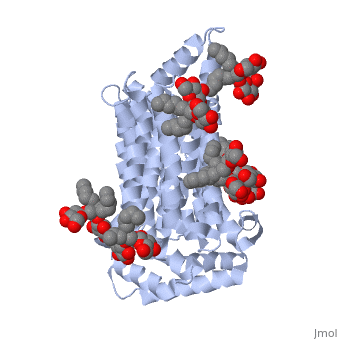Sanbox glut3
From Proteopedia
(Difference between revisions)
| Line 11: | Line 11: | ||
== Disease in Humans == | == Disease in Humans == | ||
| - | =Type 2 Diabetes= | + | ===Type 2 Diabetes=== |
Alzheimer’s disease, shows levels of impaired glucose uptake and metabolism, which leads to the downgrade of many other factors in the brain. GLUT3 is responsible for transporting glucose from extracellular space to neuronal tissue (i.e. dendrites and axons). Decreased levels of GLUT3 in Alzheimer brain shows a positive correlation to decreased levels of N-acetylglucosamine. The impaired presence of GLUT3 leads to hyperphosphorylation of the Tau protein, which normally stabilizes neuronal microtubules. Lastly there is a reduction in the transcription for factor hypoxia-inducible factor 1, which plays a role in glucose metabolism in the brain. The comparison between a normal healthy brain and an Alzheimer brain relieved that there was a 25-30% decrease in GLUT3 levels in the Alzheimer brain. | Alzheimer’s disease, shows levels of impaired glucose uptake and metabolism, which leads to the downgrade of many other factors in the brain. GLUT3 is responsible for transporting glucose from extracellular space to neuronal tissue (i.e. dendrites and axons). Decreased levels of GLUT3 in Alzheimer brain shows a positive correlation to decreased levels of N-acetylglucosamine. The impaired presence of GLUT3 leads to hyperphosphorylation of the Tau protein, which normally stabilizes neuronal microtubules. Lastly there is a reduction in the transcription for factor hypoxia-inducible factor 1, which plays a role in glucose metabolism in the brain. The comparison between a normal healthy brain and an Alzheimer brain relieved that there was a 25-30% decrease in GLUT3 levels in the Alzheimer brain. | ||
Revision as of 05:35, 17 November 2015
Facilitated Glucose Transporter 3, Solute Carrier Family 2 (GLUT3/ SLC2A3) in Homo Sapiens
| |||||||||||
References
- ↑ 1.0 1.1 1.2 1.3 Long, W., & Cheeseman, C. I. (2015). Structure of, and functional insight into the GLUT family of membrane transporters. Cell Health and Cytoskeleton, 7, 167-183. doi:10.2147/CHC.S60484
- ↑ Kipmen-Korgun, D., Bilmen-Sarikcioglu, S., Altunbas, H., Demir, R., & Korgun, E. T. (2009). Type-2 diabetes down-regulates glucose transporter proteins and genes of the human blood leukocytes.Scandinavian Journal of Clinical and Laboratory Investigation, 69(3), 350-358. doi:10.1080/00365510802632163
- ↑ 3.0 3.1 Simpson,I. A., Dwyer, D., Malide, D., Moley, K. H., Travis, A., & Vannucci, S. J. (2008). The facilitative glucose transporter GLUT3: 20 years of distinction. American Journal of Physiology - Endocrinology and Metabolism, 295(2), E242-E253. doi:10.1152/ajpendo.90388.2008
- ↑ Maher, F., Vannucci, S. J., & Simpson, I. A. (1994). Glucose transporter proteins in brain. FASEB Journal, 8(13), 1003-1011.
- ↑ Xu, J., Lu, C., Wang, J., Zhang, R., Qian, X., & Zhu, H. (2015). Regulation of human trophoblast GLUT3 glucose transporter by mammalian target of rapamycin signaling. International Journal of Molecular Sciences, 16(6), 13815-13828. doi:10.3390/ijms160613815
- ↑ Liu, Y., Liu, F., Iqbal, K., Grundke-Iqbal, I., & Gong, C. -. (2008). Decreased glucose transporters correlate to abnormal hyperphosphorylation of tau in alzheimer disease. FEBS Letters, 582(2), 359-364. doi:10.1016/j.febslet.2007.12.035
- ↑ 7.0 7.1 http://www.ebi.ac.uk/pdbe/entry/pdb/5c65/
- ↑ http://oca.weizmann.ac.il/oca-bin/ocaids?id=5c65
- ↑ 9.0 9.1 9.2 9.3 Deng, D., Sun, P., Yan, C., Ke, M., Jiang, X., Xiong, L., . . . Yan, N. (2015). Molecular basis of ligand recognition and transport by glucose transporters. Nature, 526(7573), 391-396. doi:10.1038/nature14655
- ↑ http://www.rcsb.org/pdb/explore.do?structureId=5C65
- ↑ http://www.ebi.ac.uk/pdbe/entry/pdb/5c65/bound/37X
- ↑ http://www.ebi.ac.uk/pdbe/entry/pdb/5c65/bound/Y01
- ↑ 13.0 13.1 Naftalin RJ, Holman GD. Transport of sugars in human red cells. In: Ellory JC, Lew V, editors. \ Membrane Transport in Red Cells. New York, NY, USA: Academic Press; 1977.
- ↑ 14.0 14.1 Carruthers, A., DeZutter, J., Ganguly, A., & Devaskar, S. U. (2009). Will the original glucose transporter isoform please stand up! American Journal of Physiology - Endocrinology and Metabolism, 297(4), E836-E848. doi:10.1152/ajpendo.00496.2009
- ↑ Jardetzky, O. (1966). Simple allosteric model for membrane pumps [27]. Nature, 211(5052), 969-970. doi:10.1038/211969a0
- ↑ Abramson J, Smirnova I, Kasho V, Verner G, Kaback HR, Iwata S. Structure and mechanism of the lactose permease of Escherichia coli. Science. 2003;301:610–615.
- ↑ Caulfield MJ, Munroe PB, O’Neill D, et al. SLC2A9 is a high-capacity urate transporter in humans. PLoS Med. 2008;5:1509–1523.
- ↑ Vollers, S. S., & Carruthers, A. (2012). Sequence determinants of GLUT1-mediated accelerated-exchange transport: Analysis by homology-scanning mutagenesis. Journal of Biological Chemistry, 287(51), 42533-42544.doi:10.1074/jbc.M112.369587

